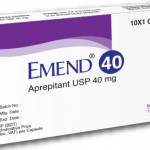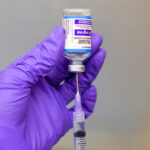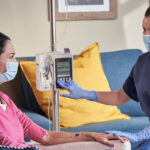How Long Does Emend Last in The Body?

Emend (Aprepitant) is used with other medications to help prevent nausea and vomiting caused by cancer drug treatment (chemotherapy). Cancer treatments, such as chemotherapy or radiation therapy can cause nausea and vomiting. Some other drugs, such as targeted therapy and immunotherapy can cause nausea and vomiting too. There are many different kinds of each type of treatment. Some can make you have nausea and/or vomiting while others might not.
Emend (Aprepitant) works by blocking one of the body’s natural substances (substance P/neurokinin 1) that causes vomiting. This medication will not treat nausea or vomiting that has already started. Ask your doctor.
Who makes Emend?
Emend is a registered trademark of Merck Sharp & Dohme Corp a research-intensive biopharmaceutical company. The Company discovers, develops, and provides medicines, vaccines, and health products for people and animals. Merck Sharp & Dohme serves customers worldwide.
How does Emend work?
Aprepitant, the active substance in Emend, is a neurokinin 1 (NK1) receptor antagonist. It prevents a chemical in the body (substance P) from attaching to the NK1 receptors. When substance P attaches to these receptors, it causes nausea and vomiting. By blocking the receptors, Emend can prevent nausea and vomiting caused by chemotherapy.
How to use Emend
Emend is available as capsules and as a powder to be made up into an oral suspension (a liquid to be drunk). The medicine can only be obtained with a prescription.
Emend capsules are used in adults and children from 12 years of age; children between 6 months and 12 years of age are given an oral suspension. Only a healthcare professional should prepare the oral suspension.
The usual dose of Emend in adults and children from 12 years of age is 125 mg by mouth one hour before the start of chemotherapy and 80 mg each day for the next two days. It is given with other medicines that also prevent nausea and vomiting such as dexamethasone and ondansetron.
In children between 6 months and 12 years of age, Emend oral suspension is given and the dose depends on the patient’s weight. Emend oral suspension is given one hour before the start of chemotherapy, and once a day for the next 2 days
Read the Patient Information Leaflet if available from your pharmacist before you start taking aprepitant and each time you get a refill. If you are taking the liquid form of this medication, read the Instructions for Use sheet for directions on the proper use of this medication. If you have any questions, ask your doctor or pharmacist.
Take this medication by mouth with or without food as directed by your doctor. If you are taking capsules, swallow the capsules whole. The safety and efficacy of the 80 mg and 125 mg capsules have not been demonstrated in children less than 12 years of age.
How long does Emend last in the body?
The plasma clearance rate of Emend is dose-dependent, decreasing with increased dose, and ranged from approximately 60 to 72 mL/min in the therapeutic dose range. The terminal half-life ranged from approximately 9 to 13 hours. However, studies have shown that the effects of Emend can last for up to one month (28 days) after your last dose of this medication.
How effective is Emend?
An analysis of efficacy in subpopulations demonstrated that, regardless of age category, gender, Emend provides better antiemetic prophylaxis and emetogenicity of chemotherapy as compared to dexamethasone.





